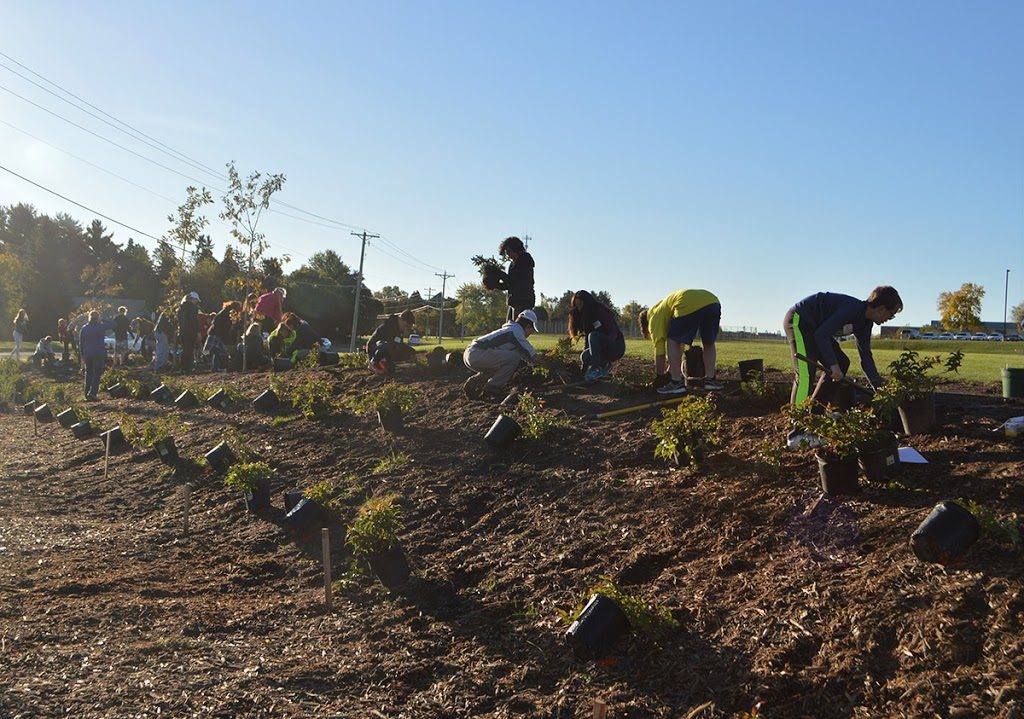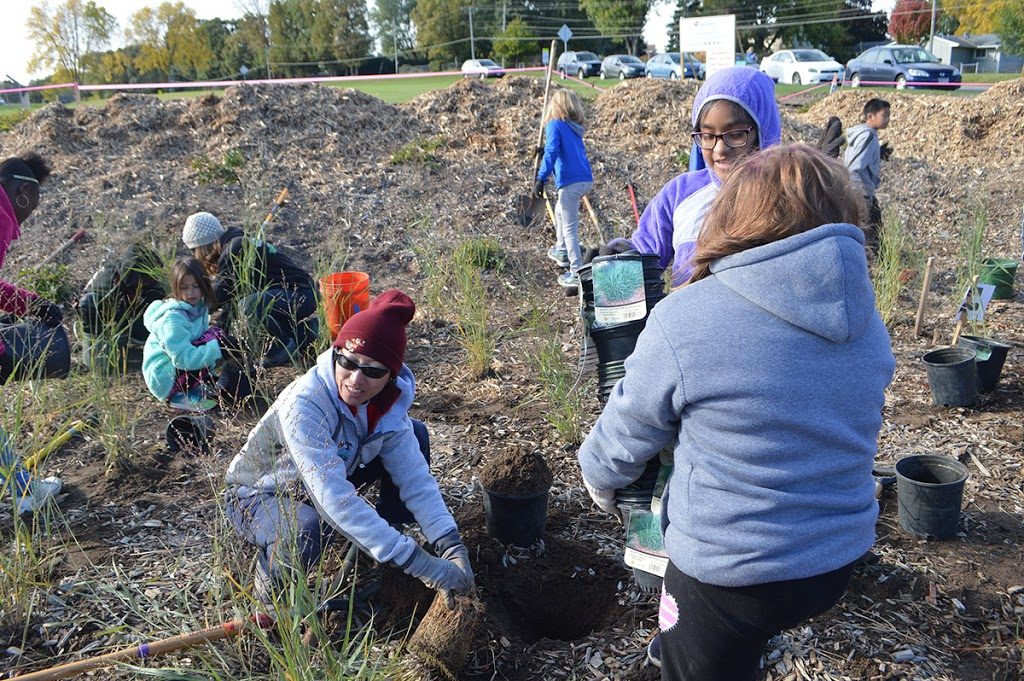
Announcing the arrival of twins – Woodbury rain gardens
by Sage Passi
Rain Gardens, like births, are harbors for crests and hurdles, heroines and heroes. This birth analogy surfaced in an article I wrote to describe Woodbury’s first school rain garden created at Crosswinds Arts and Sciences ten years ago. Woodbury Elementary School’s latest project is the “sixth child” in our most recent series of school rain gardens.
 These two rain gardens emerged last month as the final demonstration sites in Clean Water Legacy and District cost share funded school projects, which were initiated in 2014 to treat runoff from large impervious expanses of parking lots, driveways and roads adjacent to schools in our district.
These two rain gardens emerged last month as the final demonstration sites in Clean Water Legacy and District cost share funded school projects, which were initiated in 2014 to treat runoff from large impervious expanses of parking lots, driveways and roads adjacent to schools in our district. |
| Fourth graders “rock it” by planting prairie dropseed on the rain garden berm on School Drive. Across the street is the second rain garden. |
 |
|
The Woodbury Elementary and Middle School campus areas that produce runoff to Battle Creek Lake
include the blue areas (2.5 acres of impervious surfaces) and the green areas (5.5 acres) that
are considered semi-impervious since much of the turf is compacted and contributes runoff.
|
Strong school advocates
Woodbury Elementary was granted a letter grade of “A” in a watershed district-wide public school assessment process and ranked as a top priority because it had high ratings for potential stormwater benefits, constructability and educational value. The people involved in this project are equally deserving of high marks.
 |
| Fourth graders contemplate the amount of impervious parking lot and roadway surfaces that will drain to their new rain gardens. |
All hands on deck
With Woodbury we started by engaging fourth grade classes in the fall of 2016 to the spring 2017 with a variety of educational activities with help from Master Water Stewards, Master Gardeners and Washington Conservation District staff. Fourth graders from this school had been attending the Metro Children’s Water Festival for the past three or more years, so we knew there was some interest in water issues. But this event had been our only previous contact with students from this school.
 |
| Melissa Habeck’s seventh grade science students kick off the planting marathon by planting native shrubs on the hillside. |
 |
| Wrestling with a rootbound pot is sometimes the only way to free a plant. |
 |
| This student knew exactly how to loosen this plant from its pot. He admitted he had a lot of experience planting prior to the project. |
I believe it was well worth the long wait to position this Woodbury project at the end of the series. As a watershed district, we needed to be ready to take on a project of this magnitude, and we had certainly learned a lot during previous projects that we could apply here.
Meet our team!
The people are what make these projects come alive. Engaging students and partners in the planting, for me, is always the frosting on the cake. But the planting process is also the measure of our true grit! Here are some of the people who helped by hauling equipment, working with students and performing countless other tasks needed to get 1,433 native plants in the ground.
 |
|
Back (L-R): Sage Passi, Scott Hanson, Stephanie Wang, Carmen Johnson, Anna Barker, Angie Hong and Judy Koster.
Front (L-R): Konnie Her and Lauren Haydon.
|
 |
| Angie Hong, Washington Conservation District, takes a moment to pause for the camera. |
 |
|
Lauren Haydon (center), Washington Conservation District, helps break through
compacted berm so that students can plant their gallon pots of prairie dropseed.
|
 |
| Judy Koster, Washington County Master Gardener, helped with the planting all three days. When I thanked her afterwards by email she responded by saying, “It was fun working with you and your team. You can call on me as a volunteer for other local projects.” |
 |
| Anna Barker, Washington County Master Gardener and Master Water Steward, recruited her fellow Master Gardeners for the project and was a great support person who worked with the classes. |
Five Washington County Master Gardeners (Anna Barker, Jody Koster, Carmen Johnson, Lisa Moran and Laura Opsahl) stepped up to the plate to help on the project. I was thrilled to have their involvement on multiple days because there had been a long hiatus in their involvement with the District over the past ten years (except for Anna B) as their organization experienced a lot of transitions.
 |
| L-R: Lisa Moran and Carmen Johnson, Washington County Master Gardeners, and Angie Hong. |
Many years ago teams of Washington Master Gardeners worked with us on several demonstration home rain gardens as we were learning the process of design and installation. They also helped us at Crosswinds School. So getting them involved again was a giant leap forward. We also had the great assistance of a Ramsey County Master Gardener, Don Vegoe.
 |
| Stephanie Wang, Woodbury Master Water Steward, teases the roots of a plant the students will put in the ground. |
 |
| Scott Hanson, Woodbury parent and volunteer extraordinaire, protects newly planted Joe Pye weed with several stakes. |
Tracy Leavenworth kept up the pace of providing orientation demonstrations for each of the 17 classes and assisted us with layout and coordination each day.
 |
| Tracy Leavenworth demonstrates how to plant. |
Chris O’Brien, our communications coordinator, assisted with planting and captured this time-lapse video.
 |
| Paige Ahlborg, watershed project manager, assists students with planting. |
Working with the students and their teachers is where the rubber meets the road, so to speak, and the purpose of this project rings loud and strong. The true affirmation of our work comes when you open up the possibilities for students to become empowered and they get to express the joy of digging in the dirt, handling the plants and working together to solve community issues.
 |
| Thanks to Wetland Habitats for installing interpretive signs at each of our six rain garden projects. |
Our many thanks to the teachers and their students who participated in these projects. Fourth grade: Nicky Thompson, Melissa Craig, Alana Hansen and Zach Hendrickson. Fifth grade teachers: Ali Flaata, Burt Roberts and Patti Diamond. At the Middle School level, science teachers: Ashley Schultz, David Rafferty and Melissa Habeck. We couldn’t have done it without you.